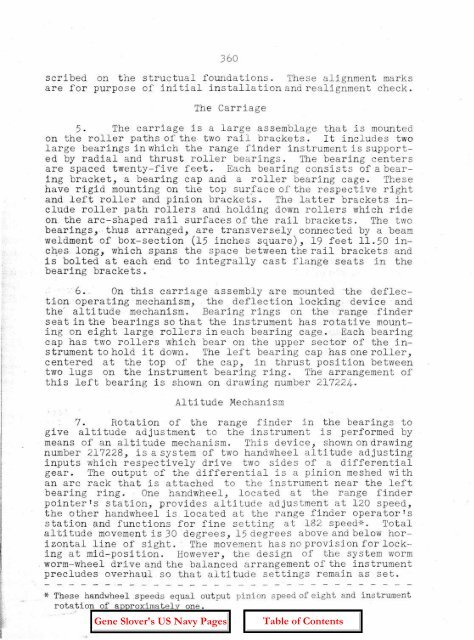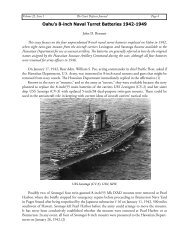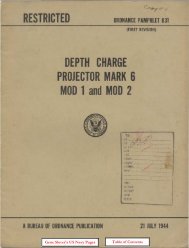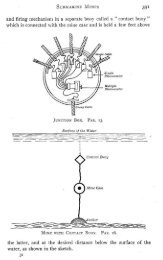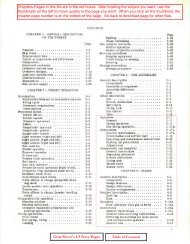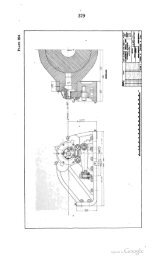OP-755 Part 2 Pages 197-401 - Personal Page of GENE SLOVER
OP-755 Part 2 Pages 197-401 - Personal Page of GENE SLOVER
OP-755 Part 2 Pages 197-401 - Personal Page of GENE SLOVER
Create successful ePaper yourself
Turn your PDF publications into a flip-book with our unique Google optimized e-Paper software.
,<br />
i<br />
I<br />
!<br />
360<br />
scri bed on the s truc tual foundations. These alignment marks<br />
are for purpose <strong>of</strong> ini tial installation and realignment check.<br />
The Carriage<br />
5. The carriage is a large assemblage that is mounted<br />
on the roller paths <strong>of</strong> the two rail brackets. It includes two<br />
large bearings in which the range finder instrument is supported<br />
by radial and thrust roller bearings. The bearing centers<br />
are spaced twenty-five feet. Each bearing consists <strong>of</strong> a bearing<br />
bracket, a bearing cap and a roller bearing cage. These<br />
have rigid mounting on the top surface <strong>of</strong> the respective right<br />
and left roller and pinion brackets. The latter brackets include<br />
roller path rollers and holding down rollers which ride<br />
on. the arc-shaped rail surfaces <strong>of</strong> the rail brackets. The two<br />
bearings,· thus arranged, are transversely connected by a beam<br />
weldment <strong>of</strong> box-section (15 inches square), 19 feet 11.50 inches.<br />
long, which spans the space between the rail brackets and<br />
is bolted at each end to integrally cast flange seats in the<br />
bearing brackets ..<br />
. 6. On this carriage assembly are mounted the deflection<br />
operating mechanism, . the deflection locking device' and<br />
the al ti tude mechanism. Bearing rings on the range finder<br />
seat in the bearings so that the instrument has rotative mounting<br />
on eight large rollers in each bearing cage. Each bearing<br />
cap has two rollers which bear on the upper sector <strong>of</strong> the ins<br />
trument to hold it down. The left bearing cap has one roller,<br />
centered at the top <strong>of</strong> the cap, in thrust position between<br />
two lugs on the instrument bearing ring. The arrangement <strong>of</strong><br />
this left bearing is shown on drawing number 217224.<br />
Altitude Mechanism<br />
7. Rota tion <strong>of</strong> the range finder in the bearings to<br />
give altitude adjustment to the instrument is performed by<br />
means <strong>of</strong> an alti tude mechanism. This device, shownon drawing<br />
number 217228, is a system <strong>of</strong> two handwheel altitude adjusting<br />
inpu ts which respec ti vely drive two sides <strong>of</strong> a differential<br />
gear. The output <strong>of</strong> the differential is a pinion meshed with<br />
an arc rack that is attached to the instrument near the left<br />
bearing ring. One handwheel, located at the range finder<br />
pointer's station, provides altitude adjustment at 120 speed,<br />
the other handwheel is located at the range finder operator's<br />
s ta tion and func tions for fine setting at 182 speed+. Total<br />
alti tude movement is 30 .degrees, 15 degrees above and below horizontal<br />
line <strong>of</strong> sight. The movement has no provision for locking<br />
at mi.d=posI tion. However, the design <strong>of</strong> the system worm<br />
. worm-wheel drive and the balanced arrangement <strong>of</strong> the instrument<br />
precludes overhaul so that altitude settings remain as set.<br />
* These handwheelspeeds equal output pinion speed <strong>of</strong> eight and instrument<br />
rotation <strong>of</strong> approximately one.<br />
"


